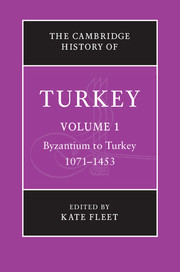Book contents
- Frontmatter
- 1 Introduction
- 2 The Byzantine Empire from the eleventh to the fifteenth century
- 3 Anatolia under the Mongols
- 4 Anatolia, 1300–1451
- 5 The incorporation of the Balkans into the Ottoman Empire, 1353–1453
- 6 Ottoman warfare, 1300–1453
- 7 The Turkish economy, 1071–1453
- 8 Art and architecture, 1300–1453
- 9 Social, cultural and intellectual life, 1071–1453
- Glossary
- Bibliography
- Index
- References
8 - Art and architecture, 1300–1453
Published online by Cambridge University Press: 28 March 2010
- Frontmatter
- 1 Introduction
- 2 The Byzantine Empire from the eleventh to the fifteenth century
- 3 Anatolia under the Mongols
- 4 Anatolia, 1300–1451
- 5 The incorporation of the Balkans into the Ottoman Empire, 1353–1453
- 6 Ottoman warfare, 1300–1453
- 7 The Turkish economy, 1071–1453
- 8 Art and architecture, 1300–1453
- 9 Social, cultural and intellectual life, 1071–1453
- Glossary
- Bibliography
- Index
- References
Summary
The century and a half between the disappearance of the Seljuk dynasty in Anatolia at the beginning of the fourteenth century and the conquest of Constantinople by the Ottomans in 1453 is a period in which Turkish art and architecture underwent a significant transformation. It is a time when, on the one hand, forms, functions, vocabularies and techniques which defined Rum Seljuk art and architecture continued to flourish in the towns of the central and eastern Anatolia, while on the other, striking departures from that tradition, drawing on diverse sources, including late Byzantine, Timurid and Mamluk art, manifest themselves, in particular in the Turkish border lands of western Asia Minor. In part, no doubt, the artistic ferment and change of the period are related to the decentralisation of political authority that characterises Anatolia throughout the fourteenth and early fifteenth centuries. Because of this political division, the centralised patronage of the Rum Seljuks, which had produced a more or less homogeneous period style in the thirteenth century, was replaced by a patronage dispersed throughout a constellation of small principalities, the rulers of which often sought to enhance their prestige and legitimacy through ambitious building programmes. The result, not surprisingly, was the proliferation of regional centres of architectural activity, and with this the emergence of a number of more or less distinctive regional styles.
- Type
- Chapter
- Information
- The Cambridge History of Turkey , pp. 266 - 352Publisher: Cambridge University PressPrint publication year: 2009



